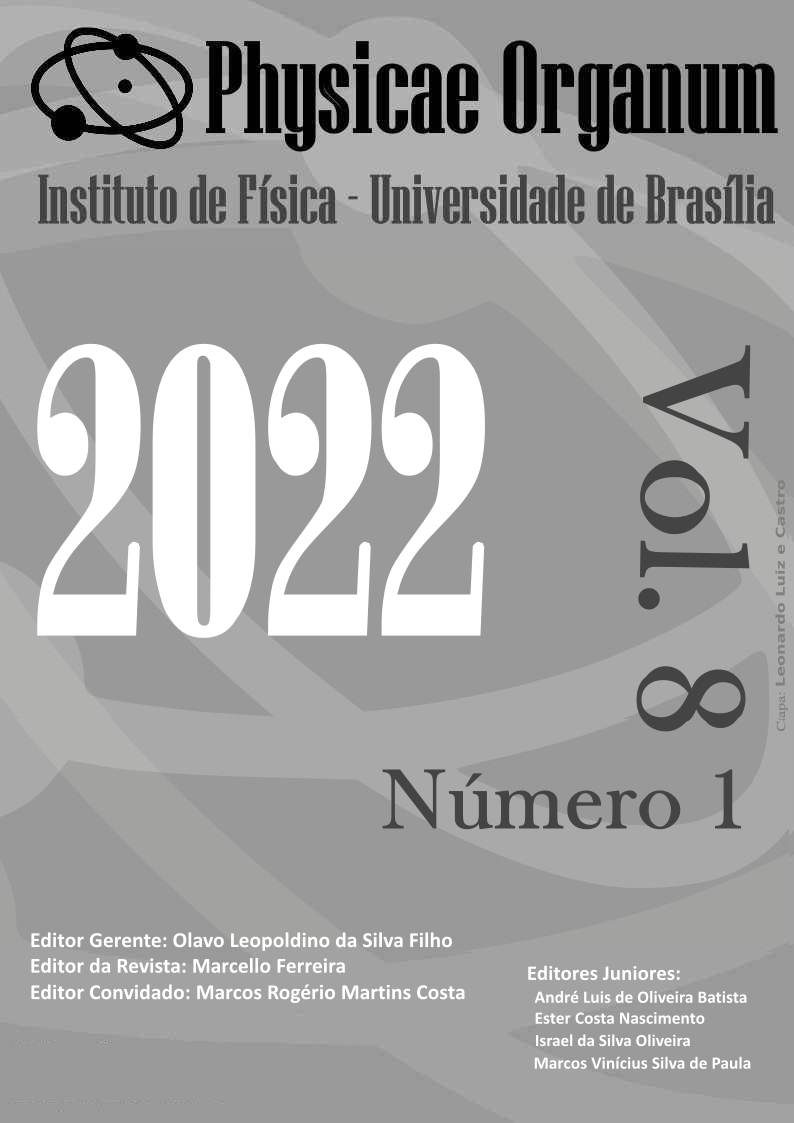RESEARCH FOR SCIENCE TEACHING
HOW TO BLOCK AN ELECTROMAGNETIC WAVE?
DOI:
https://doi.org/10.26512/2446-564X2022e42289Keywords:
Science teaching by investigation, Investigative method, Pedagogical theory and practice, Electromagnetic wavesAbstract
The present research refers to the theory and practice of teaching by investigation, and its theme is electromagnetic waves. The methodology was applied through investigative Physics classes that dealt with the content of electromagnetic waves, with experimental activities in UnB's Moodle (Workshop), and the target audience were students from the 1st, 2nd and 3rd grades of High School from several schools. public in the state of Goiás. This application aimed to improve the pedagogical practice, making it possible to improve the student's teaching-learning performance. For this, field research was carried out with a qualitative approach of an applied nature and of an exploratory nature. We conclude that investigative activities favor the construction of significant learning by high school students around the subject of electromagnetic waves, a subject that is present in their daily lives. The theoretical foundation was based on the assumptions of Carvalho (2013, 2018) in the aspect of the research approach, and David Ausubel with his theoretical and methodological foundations of pedagogical practice, and the meaningful learning of students.
Downloads
References
ANDRADE, G. T. B. de. Percursos históricos de ensinar ciências através de atividades investigativas. Uma versão inicial deste trabalho foi apresentada no VII Encontro Nacional de Pesquisa em Educação em Ciências em Florianópolis (UFSC) em 2009. Ensaio Pesquisa
em Educação em Ciências (Belo Horizonte) [online]. 2011, v. 13, n. 1 [Acessado 31 agosto 2021], pp. 121-138. Disponível em: <https://doi.org/10.1590/1983-21172013130109>.
AUSUBEL, D. P. Aquisição e retenção de conhecimentos: Uma perspectiva cognitiva. 1.ª Edição PT-467- janeiro de 2003.
BRITO, L. O; FIREMAN, E. C. Ensino de Ciências por investigação: proposta didática “para além” de conteúdo conceituas. Experiências em Ensino de Ciências V.13, No.5.
CARVALHO, A. M. P. Ensino de Ciências por Investigação: condições para implementação em sala de aula. São Paulo: Cengage Learning, 2013a. Instituto de Física 161Physicae Organum, v. 8, n. 1, p. 150-162, Brasília, 2022.
CRESWELL, J. W. Projeto de pesquisa: métodos qualitativo, quantitativo e misto; tradução Magda Lopes; 3ª edição. Porto Alegre: Artmed, 2010.296p.:il.; 23cm.
FREIRE, Paulo. Pedagogia do oprimido, 17ª. ed. Rio de Janeiro, Paz e Terra, 1987.
MOREIRA, M. A. Aprendizagem significativa em mapas conceituais. V.24, n .6. Porto Alegre: UFRGS, Instituto de Física, 2013.
SÁ, E. F, et al. As características das atividades investigativas segundo tutores e coordenadores de um curso de espacialização em ensino de ciências. Disponível em: <http://abrapecnet.org.br/atas_enpec/vienpec/CR2/p820.pdf>. Acesso em: 10 de agosto de 2021.
ZÔMPERO, A. F.; LABURÚ, C. E. Atividades investigativas no ensino de ciência: aspectos históricos e diferentes abordagens. Rev. Ensaio. v.13, Belo Horizonte 2011.
Downloads
Published
How to Cite
Issue
Section
License
Copyright (c) 2022 Physicae Organum

This work is licensed under a Creative Commons Attribution-NonCommercial-ShareAlike 4.0 International License.
Autores que publicam nesta revista concordam com os seguintes termos:
- Autores mantém os direitos autorais e concedem à revista o direito de primeira publicação, sendo o trabalho simultaneamente licenciado sob a Creative Commons Attribution License o que permite o compartilhamento do trabalho com reconhecimento da autoria do trabalho e publicação inicial nesta revista.
- Autores têm autorização para assumir contratos adicionais separadamente, para distribuição não-exclusiva da versão do trabalho publicada nesta revista (ex.: publicar em repositório institucional ou como capítulo de livro), com reconhecimento de autoria e publicação inicial nesta revista.
- Autores têm permissão e são estimulados a publicar e distribuir seu trabalho online (ex.: em repositórios institucionais ou na sua página pessoal) a qualquer ponto antes ou durante o processo editorial, já que isso pode gerar alterações produtivas, bem como aumentar o impacto e a citação do trabalho publicado (Veja O Efeito do Acesso Livre).




